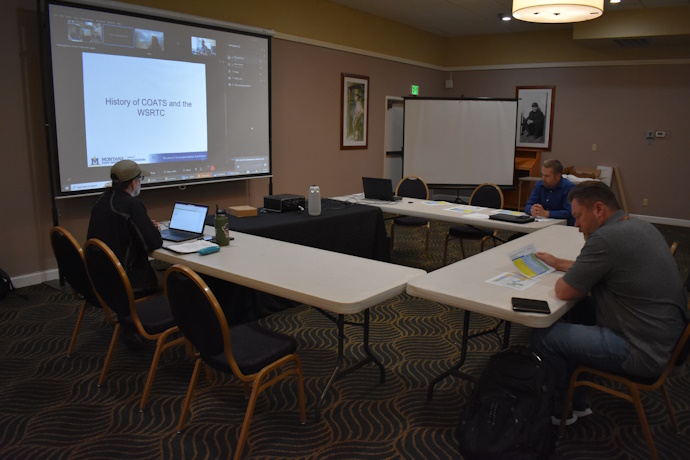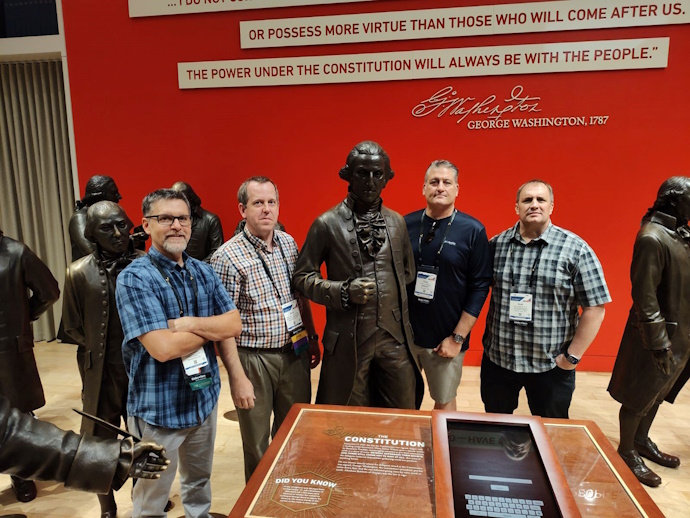UPDATE: Friday, September 27th, 2024
WSRTC: Consortium Convenes for 2024 Annual Meeting, Attends NRITS Conference
Steering Committee members convened in Yreka, California, on June 18th, for the 14th annual meeting of the Western States Rural Transportation Consortium (WSRTC). All five member states (California, Oregon, Washington, Nevada, Utah) and both research institutions (WTI at Montana State University, Montana Tech) were represented. The meeting’s agenda (pdf), presentation (pdf), and official minutes (pdf) can be reviewed here and on the WSRTC Documents page.
The meeting was called to order by Leann Koon and Andres Chavez, who welcomed attendees and facilitated personal introductions. Leann provided an overview of the meeting’s purpose and agenda.
With the start of the 2024 Western States Forum planned for later in the afternoon, Leann began the meeting with a preview of the agenda and schedule of events for the Forum. Speakers representing four of the Consortium member states (CA, NV, UT, WA) will be presenting along with others on seven different topics. Speakers and representatives at the meeting shared some background and a quick synopsis of their presentation. We are anticipating a diverse audience – seven states representing six DOTs, including four Consortium member states, two universities, and the Southwest Research Institute. You can read more about the event and take a look at the technical presentations on the 2024 Forum page.
Next, Jeremiah Pearce and Doug Spencer spoke about the history of the WSRTC and how it evolved from its beginnings with the COATS project (California Oregon Advanced Transportation Systems). Oregon and California worked on several projects together in the early COATS phases and some more engineering focused training classes were conducted. Through these early experiences and conversations, a need became apparent for more in-depth information sharing with an engineering focus and more details. This was the seed for the Western States Forum. Pictured here are meeting participants in person and online reviewing the project’s roots. Clockwise from left: Andres Chavez (Caltrans DRISI), online participants, Jeremiah Pearce (Caltrans District 2), Jacob Grivette (Nevada DOT).

Photo by Doug Galarus
Phase 1 TPF-5(241) of the WSRTC concluded in 2023 and Phase 2, TPF-5(494), runs through March of 2027. The group reviewed the status of the Pooled Fund, contributions and obligations, and a dashboard of activities. There are four active task orders:
- Evaluation of the Fotokite Tethered Unmanned Aerial System for DOT Operations in Network-Deprived Areas (AHMCT, UC Davis)
- Chain-Up Delay Tracking and Estimation (Montana Tech)
- WSRTC Meeting Coordination, Western States Forum, Website Maintenance (WTI) – WTI Task Order 15
- WSRTC Meeting Coordination, Western States Forum, Website Maintenance (WTI) – WTI Task Order 16
Doug Galarus from Montana Tech reviewed several projects he is working on through the Consortium. He gave an overview of the Chain-Up Delay Tracking and Estimation including some images demonstrating the need for the project. The WeatherShare Maintenance project recently started and will run through January of 2027. The project’s objective is to maintain WeatherShare as the central repository for Caltrans RWIS data and weather information. Support for the One-Stop-Shop (OSS) project continues, and Doug discussed the application, its use, and usage statistics. He will be presenting “OSS by the Numbers - Analytics and their use on the One-Stop-Shop for Rural Traveler Information, Measuring Use Across Corridors and Between Communities During Winter Weather Events” at the Forum this week.
The AHMCT Research Center at UC Davis is working on a project in partnership with WSDOT and Caltrans to evaluate Fotokite tethered UASs for DOT operations in network-deprived areas. The team is testing five kites, three in California and two in Washington, as a tool for incident management. The tether provides power and can allow flight up to 150 feet. Andre Chavez discussed the project’s results and challenges thus far. He noted that this project could be a good topic for a future Forum presentation.
Two pending projects include “Connected Vehicle Highway Grip Factor Reporting for Snowplows” and “Vehicle Detection on Rural Roads Using Optical Fiber Sensing Technology.” Jeremiah Pearce reviewed the problem statements for both projects. Check back for more information!
Six WSRTC representatives attended the 2024 National Rural ITS Conference and ITE Annual Meeting in Philadelphia in July. The group gathered for an informal meeting during the event. Doug Galarus and Jeremiah Pearce presented “The Western States Rural Transportation Technology Implementers Forum – Going on 20 Years of Technical Content, Transparency and Trust” during the Rural ITS Town Hall session. Here is some of the group, left to right, Andres Chavez (Caltrans DRISI), Matt Luker (Utah DOT), Tony Leingang (Washington State DOT), and Seth Daniels (Nevada DOT).

The annual meeting concluded with the traditional roundtable of ITS project work. You can read more about the many rural ITS projects the member states are working on in the meeting minutes (pdf).
To review the meeting minutes, click here, or go to the Consortium’s Documents page. You can also find the meeting presentation on the Consortium’s Documents page.
Check back later to the Forum project pages for a report on the 2024 Western States Forum.

